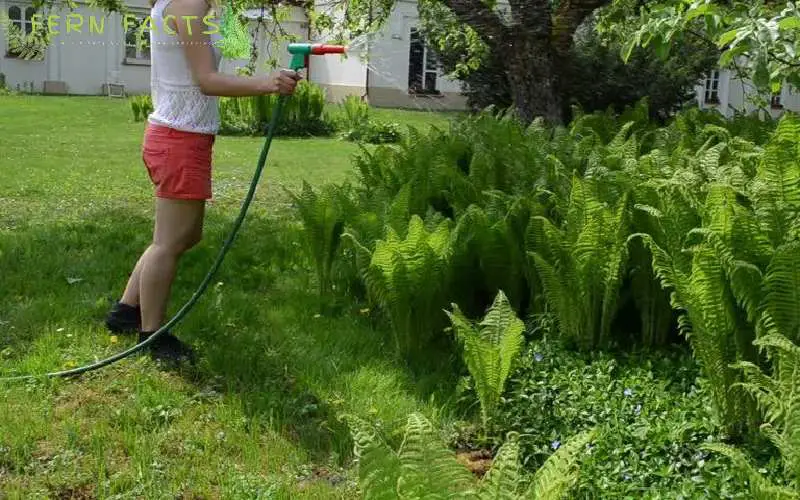How Often Do You Water Ferns
How often do you water your ferns? Are you sure you’re not making any mistakes while watering them? Because watering is a very crucial part of every fern’s active growth.
It’s one of the basic requirements of plants. If you are confused about watering your ferns then read this article thoroughly.
In this article, I’ll be discussing fern watering requirements for both indoor and outdoor plants. In addition, I’ll also give winter season watering tips, the best time to water your ferns, and how you can water your ferns.
Lastly, I’ll conclude this article by showing you some demerits of inappropriate watering along with thumb technique tips. So let’s get started.
Basic Water Requirements of Ferns
For having healthy thriving ferns, you need to give them their perfect condition to live. One of the prime reasons for having thriving ferns is sufficient watering.
Without giving them proper watering, you cannot make them thrive. Although every fern’s water requirements are not exactly the same, it’s kind of similar. In most of the cases, fern thrives in moist, damp soil. They prefer the soil to be moist and hydrated, not overly soaked.
Nonetheless, few ferns can tolerate wet soil conditions or they can also grow in submerged conditions. Conversely, few ferns can tolerate drought conditions as well.
However, the majority of the fern species thrive in moist and slightly wet conditions. So try to keep their soil in a moist condition, not overly soaked in water.
Watering Your Indoor Ferns
If your ferns are placed indoors, then their requirements might be a little different compared to your outdoor ferns.
For your indoor ferns, you need to water them twice a week or once a week according to their soil conditions.
Similarly, water the roots and the soil until they are moist enough. Don’t overwater your plants because this might give your ferns rotten roots. Give adequate amounts of watering to make them thrive.
Also, you can mist water on the fronds if the room temperature and humidity are not in balance. You can mist every day or thrice a week according to your ferns’ growth conditions.
Watering Your Outdoor Ferns
Now for your outdoor ferns, might need more watering than the indoor ones. Because outdoor ferns get more exposure to the sun and other environmental issues such as temperature, humidity, climate, and so on.
For example, outdoor ferns get more exposure to the sun although they are being kept in a shaded place. However, their temperature soaks the water from their soil more frequently and makes it dry.
In such cases, they need more water. That’s why, for your outdoor fern you can water them thrice a week. Just make sure their soil is moist and damp enough. You can simply check the soil conditions before you pour water.
If the soil is dry, then just water the plant. If the soil remains wettish and damp, then wait for a few days to dry out the water completely. Then you can water your ferns.
Winter Seasons Watering Routine
Although you can follow a normal watering schedule for other seasons, you cannot stick to that same routine in winter seasons also.
In winter seasons, most of the ferns become dormant which means they don’t grow that much. Ultimately, you can say their growth stops in that season.
So in that season, they don’t need much attention such as pruning, feeding, watering, and so on. That’s why, don’t follow your moral seasonal watering schedule in winter seasons also because it can kill your plants.
Thus, in the winter seasons, you can water them once a month or twice a month according to their soil conditions. However, they get frozen. You can add mulch for extra hydration.
Mulching your ferns also keeps them nourishing and hydrating in the winter season.
Best Time for Watering Ferns
Well, the best time for watering your ferns is early morning hours. The mild morning temperature will help your ferns to absorb water quickly and efficiently.
That’s why try to give water in the early morning for both your indoor and outdoor ferns. Also, remember don’t pour water in the mid-day hour because at that time the hot sun rays might be dangerous for your plants.
Thus, early morning watering is the best time to water your ferns.
How to Water Your Ferns
Well, to water your ferns you can use any watering can or watering bottle, pot, or sprinkling can.
- Water your ferns early in the morning. Because it allows ferns to absorb water effectively.
- Start with gentle misting to your ferns in the early morning.
- After misting, water your plants thoroughly until the water runs out from the drainage holes. Don’t let the water sit on the soil because it can kill your plants.
- Stop giving water when you feel the soil is moist and damp enough. Don’t let your ferns be on standing water.
Demerits of Overwatering and Underwatering
Let’s look at some predictable problems of your inappropriate watering.
Overwatering
It’s a pretty common mistake that every person can make which is overwatering your plants. The majority of ferns cannot tolerate standing water or waterlogged situations.
You might be thinking that you are taking extra care of your ferns. But your extra care can lead your plants to suffer several problems such as rotten roots, yellow-brown leaves, and bacterial or fungus diseases.
Once their roots start to rot, it’s very difficult to save the plants. That’s why you have to ensure you don’t overwater your plants.
Underwatering
Also, careless conditions can also lead your ferns to suffer a lot. Your irresponsible watering habit can kill your plants.
Although few ferns can tolerate drought conditions, excessive drought situations can make their friends crispy or curled.
Ultimately, your plant will be dull and dehydrated. So, you need to be careful about your ferns watering.
ferns. In this case, you need to level up your fern’s watering level while ensuring the humidity level and sun exposure.
Thumb Technique to Check on the Soil
If you are unable to understand the moisture level of your ferns, you can use a thumb technique method. In this technique, just press your thumb into the soil before you are about to water your plant.
If your plant’s soil is too hard or dry then there will be no sign of water inside of the plants. Then you can put water into the plants.
But after pressing your thumbs, if you see water coming out of the soil is still mushy, then you don’t have to pour water on it. In that case, wait for a few days until the water is completely dry.
Then pour water on your plants. This technique will help you to understand their watering needs and requirements.
Wrap Up
In short, watering is a very crucial part for ferns to thrive. Adequate watering can lead your ferns to have thriving growth Alternatively, inappropriate watering can kill your plants.
That’s why, you need to understand their sufficient watering requirements such as your indoor, and outdoor plants, seasonal requirements, the best time to water, and the consequences of inappropriate watering.
By understanding their appropriate watering requirements, you can thrive on your ferns.







